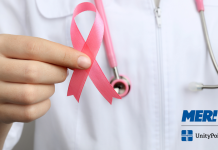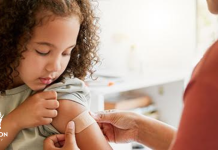Ovarian cancer is often referred to as the cancer that whispers. This is because its symptoms are often quiet and go unnoticed, which results in 70% of cases being discovered in the later stages of the disease.
My own experience with ovarian cancer involved many of the telltale symptoms… but began at a much earlier age than most. The summer before eighth grade I was unusually tired. I was never one to nap much, but suddenly I began napping almost every day after I came home from morning swim practice. By this age, my parents were both working and it was my sister and me at home by ourselves during the day, so they didn’t realize how much I was sleeping.
I also began to eat less. I just wasn’t hungry, so I stopped eating snacks during the day. Then I started eating less and less at meals. By the time the end of the summer neared, I was down to eating half a bagel in the morning and half a cup of chicken and rice for dinner. All the while, I was swimming two practices a day, but I didn’t feel hungry and I wasn’t losing weight. In fact, I gained a couple of pounds.
I started to have some changes in my bowel movements, but as a teenager, there was no way I was going to discuss this with anyone. I did, however, tell my mom that my stomach was upset, and she noticed my decreased appetite. I ended up going into the doctor, but my doctor was on vacation, so I saw a different pediatrician. He asked a variety of questions, but never felt my abdomen. He wrote off my symptoms and thought that it was just from stress.
As a new teenager, I was uncomfortable with my body and didn’t tell my parents that my stomach was getting stiff. I didn’t really realize that this was a problem until I finally got in to see my regular pediatrician. She felt my stomach and immediately became concerned. I was rushed to the hospital and had surgery to remove the tumor less that 48 hours after seeing my pediatrician.
I had a rare form of ovarian cancer that effects teens and young adults. The form I had grows very quickly, but doesn’t spread very quickly. The doctors estimated that it had been growing for three to five months, but when it was removed, it was nearly 7 inches wide and had ruptured to let out many liters of fluid. It was, however, still in stage one, so it hadn’t spread to any other organs. This is what makes my type of ovarian cancer different from most of the other forms, and what allowed it to be caught in stage one. Most of the other forms grow more slowly, but spread more quickly, which makes it difficult to detect early.
Contrary to some of the myths out there, ovarian cancer cannot be detected by pap smear or typical screenings. It often doesn’t display any major physical symptoms, like a lump you can feel. So, it is important to be on the lookout for the symptoms that are noticeable:
1. Persistent bloating
2. Changes in bladder or bowel movements
3. Feeling full quickly
4. Abdominal or pelvic pain
If these symptoms are new to you and occur for two weeks or more, see a gynecologist. One in 78 women will experience ovarian cancer in her lifetime, so it is important to not dismiss these symptoms. They may seem minor, but getting them checked out could save your life.
My journey with ovarian cancer, as well as several other women’s stories of cancer have been described in a book, In Her Shoes: Dancing in the Shadow of Cancer by Joanie Shawhan. We all had different experiences in noticing symptoms that finally lead to the discovery of our cancers. Some of us had a family history of other gynecological/breast/colon cancers, some did not, even though this is a risk factor. When I was diagnosed, I didn’t have much of a family history of cancer, but a year after my cancer diagnosis, my mom was diagnosed with breast cancer (her story is also described in In Her Shoes). Some other risk factors include being post-menopausal and over 40 years of age.
Spreading awareness of the symptoms is needed for women to be aware of the risks and catch cancer before it gets to the later stages. Early detection and treatment is key to helping to increase survival rates. Ovarian cancer awareness month is September, so spread the word and save a life!















